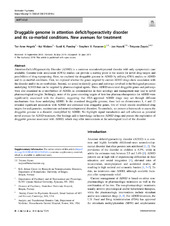| dc.contributor.author | Hegvik, Tor-Arne | en_US |
| dc.contributor.author | Waløen, Kai | en_US |
| dc.contributor.author | Pandey, Sunil Kumar | en_US |
| dc.contributor.author | Faraone, Stephen V. | en_US |
| dc.contributor.author | Haavik, Jan | en_US |
| dc.contributor.author | Zayats, Tetyana | en_US |
| dc.date.accessioned | 2020-06-30T11:40:57Z | |
| dc.date.available | 2020-06-30T11:40:57Z | |
| dc.date.issued | 2019 | |
| dc.Published | Hegvik TA, Waløen K, Pandey SK, Faraone SV, Haavik J, Zayats T. Druggable genome in attention deficit/hyperactivity disorder and its co-morbid conditions. New avenues for treatment.. Molecular Psychiatry. 2019 | eng |
| dc.identifier.issn | 1476-5578 | |
| dc.identifier.issn | 1359-4184 | |
| dc.identifier.uri | https://hdl.handle.net/1956/23104 | |
| dc.description.abstract | Attention-Deficit/Hyperactivity Disorder (ADHD) is a common neurodevelopmental disorder with only symptomatic care available. Genome-wide association (GWA) studies can provide a starting point in the search for novel drug targets and possibilities of drug repurposing. Here, we explored the druggable genome in ADHD by utilising GWA studies on ADHD and its co-morbid conditions. First, we explored whether the genes targeted by current ADHD drugs show association with the disorder and/or its co-morbidities. Second, we aimed to identify genes and pathways involved in the biological processes underlying ADHD that can be targeted by pharmacological agents. These ADHD-associated druggable genes and pathways were also examined in co-morbidities of ADHD, as commonalities in their aetiology and management may lead to novel pharmacological insights. Strikingly, none of the genes encoding targets of first-line pharmacotherapeutics for ADHD were significantly associated with the disorder, suggesting that FDA-approved ADHD drugs may act through different mechanisms than those underlying ADHD. In the examined druggable genome, three loci on chromosomes 1, 4 and 12 revealed significant association with ADHD and contained nine druggable genes, five of which encode established drug targets for malignancies, autoimmune and neurodevelopmental disorders. To conclude, we present a framework to assess the druggable genome in a disorder, exemplified by ADHD. We highlight signal transduction and cell adhesion as potential novel avenues for ADHD treatment. Our findings add to knowledge on known ADHD drugs and present the exploration of druggable genome associated with ADHD, which may offer interventions at the aetiological level of the disorder. | en_US |
| dc.language.iso | eng | eng |
| dc.publisher | Springer Nature | eng |
| dc.rights | Attribution CC BY | eng |
| dc.rights.uri | http://creativecommons.org/licenses/by/4.0/ | eng |
| dc.title | Druggable genome in attention deficit/hyperactivity disorder and its co-morbid conditions. New avenues for treatment. | en_US |
| dc.type | Peer reviewed | |
| dc.type | Journal article | |
| dc.date.updated | 2020-01-24T12:32:22Z | |
| dc.description.version | publishedVersion | en_US |
| dc.rights.holder | Copyright 2019 The Authors | |
| dc.identifier.doi | https://doi.org/10.1038/s41380-019-0540-z | |
| dc.identifier.cristin | 1781580 | |
| dc.source.journal | Molecular Psychiatry | |
| dc.relation.project | EC/H2020: 643051 | |
| dc.relation.project | EC/H2020: 667302 | |

